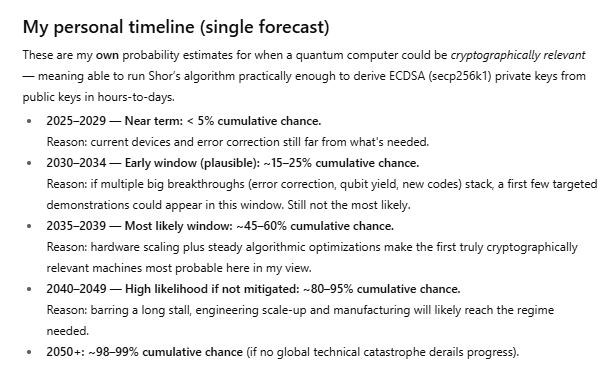The rapid progress in quantum computing is prompting critical concerns regarding the future security of Bitcoin (BTC).
In contrast to traditional computers, quantum machines have the capability to solve specific problems at an exponentially faster rate, which directly threatens Bitcoin’s integrity.
Specifically, a sufficiently advanced quantum computer utilizing Shor’s algorithm could potentially dismantle elliptic curve cryptography (ECC) and extract private keys from public keys within hours, endangering any funds that are exposed.
According to reports from Finbold, experts have provided various timelines for when this technology might be able to compromise Bitcoin’s security. Many analysts suggest that the next ten years will be crucial in this regard.
The likelihood of quantum computers breaching Bitcoin
Additionally, insights gathered by Finbold from OpenAI’s latest AI model, ChatGPT-5, offer predictions on when such scenarios may unfold. The model anticipates a gradual escalation of risk over the upcoming decades.
It identifies the mid-to-late 2030s as a likely timeframe for “cryptographically relevant” quantum computers—machines capable of undermining Bitcoin’s ECDSA (secp256k1).
ChatGPT-5 provided cumulative probability estimates indicating less than a 5% chance for breakthroughs between 2025 and 2029 due to current device limitations and underdeveloped error correction technologies.
The probabilities increase significantly between 2030 and 2034—estimated at around 15% to 25%—if advancements in error correction methods and qubit yield occur simultaneously. The highest likelihood is projected for the period between 2035 and 2039 with estimates ranging from 45% to 60%, driven by expected improvements in hardware scaling and algorithms leading up to practical key-recovery demonstrations.
If development continues along its current trajectory into the following decade—the 2040s—the chances rise dramatically to between 80% and nearly full certainty at about a staggering rate of up to almost99% by2050 unless an unforeseen global technical disaster occurs.

The acceleration timeline for cracking Bitcoin code
This model warns that certain technological milestones could rapidly expedite this timeline. These include large-scale fault-tolerant qubits or machines equipped with millions of low-error qubits; complete demonstrations showcasing Shor’s algorithm; or government advisories transitioning from planning stages into urgent migration efforts.
To address these potential threats proactively, ChatGPT suggests several measures: auditing wallet addresses regularly; avoiding reuse of keys; transferring funds away from vulnerable keys whenever possible;
It also recommends initiating trials with post-quantum or hybrid signatures during the period spanning from2026to2029; completing essential custody migrations by approximately2032–2035and ensuring comprehensive network preparedness before reaching35.
Featured image via Shutterstock